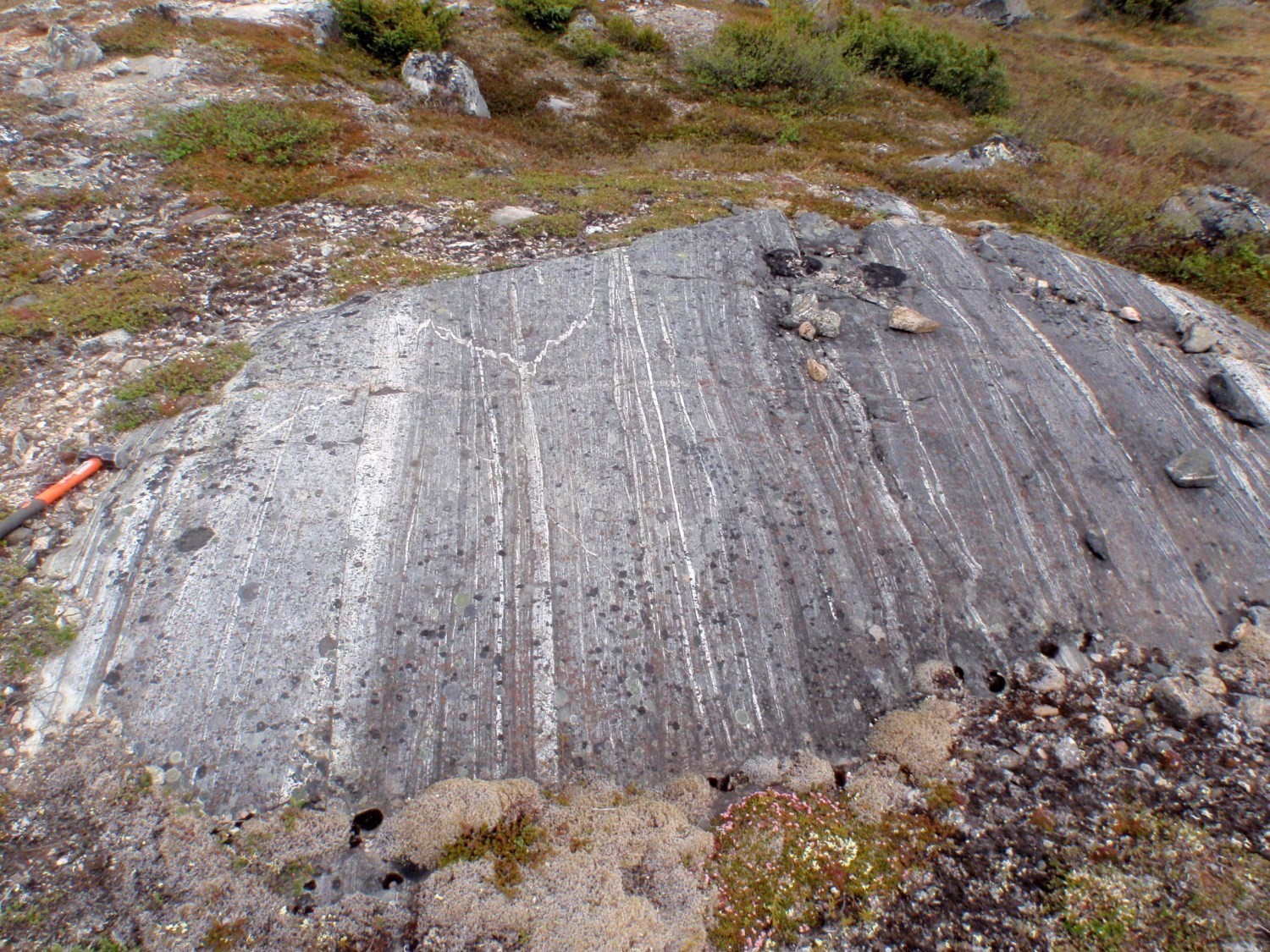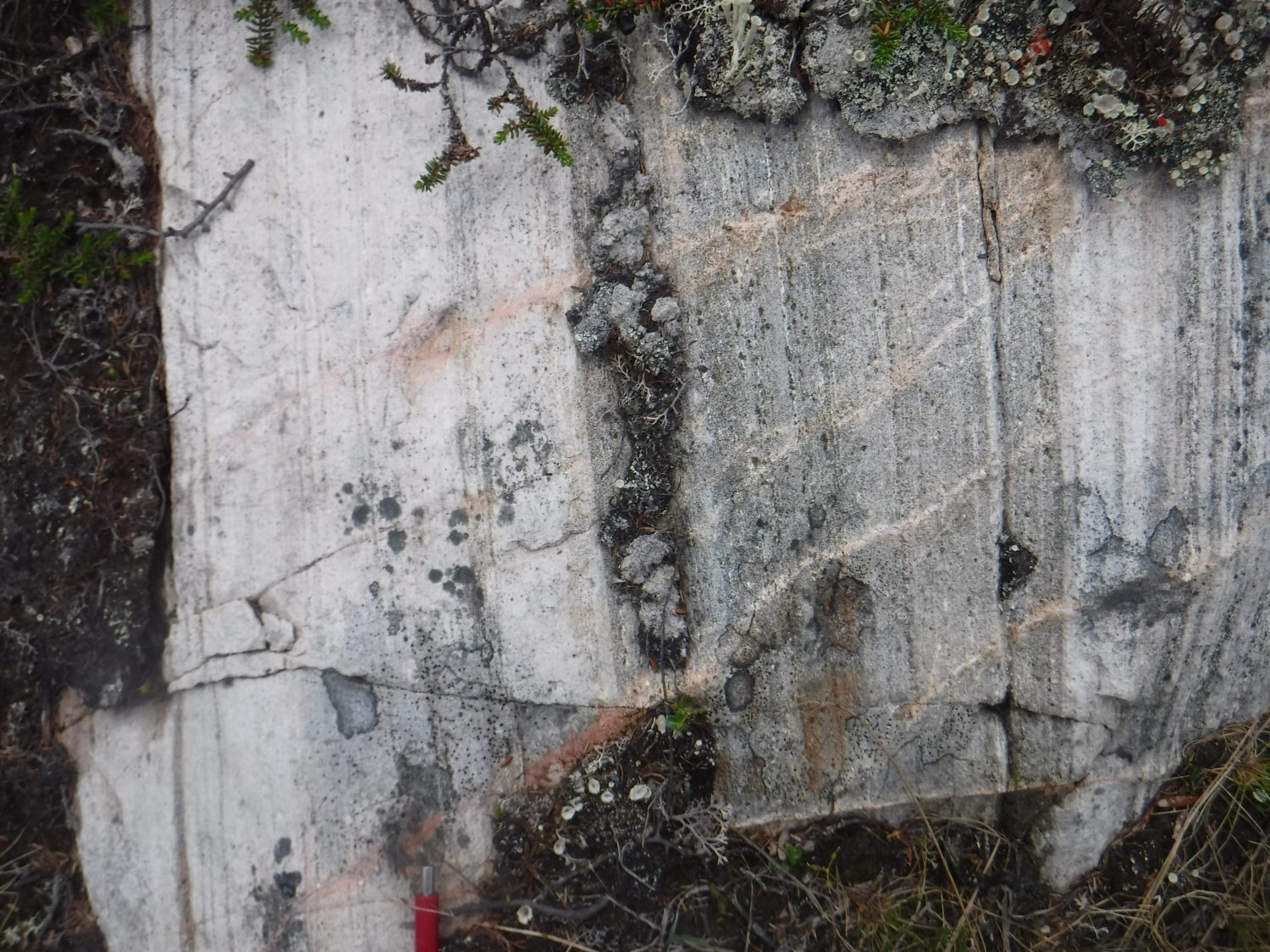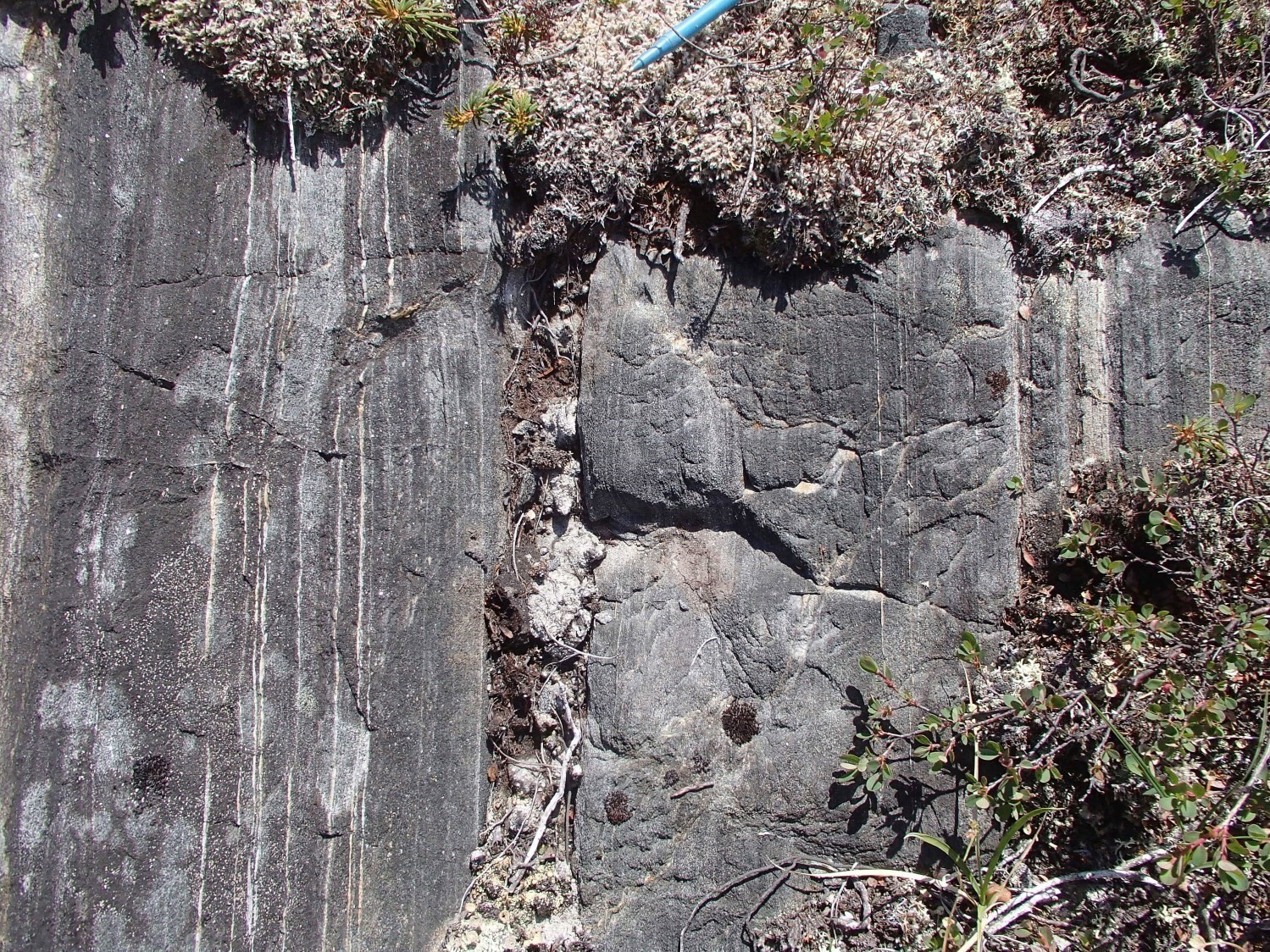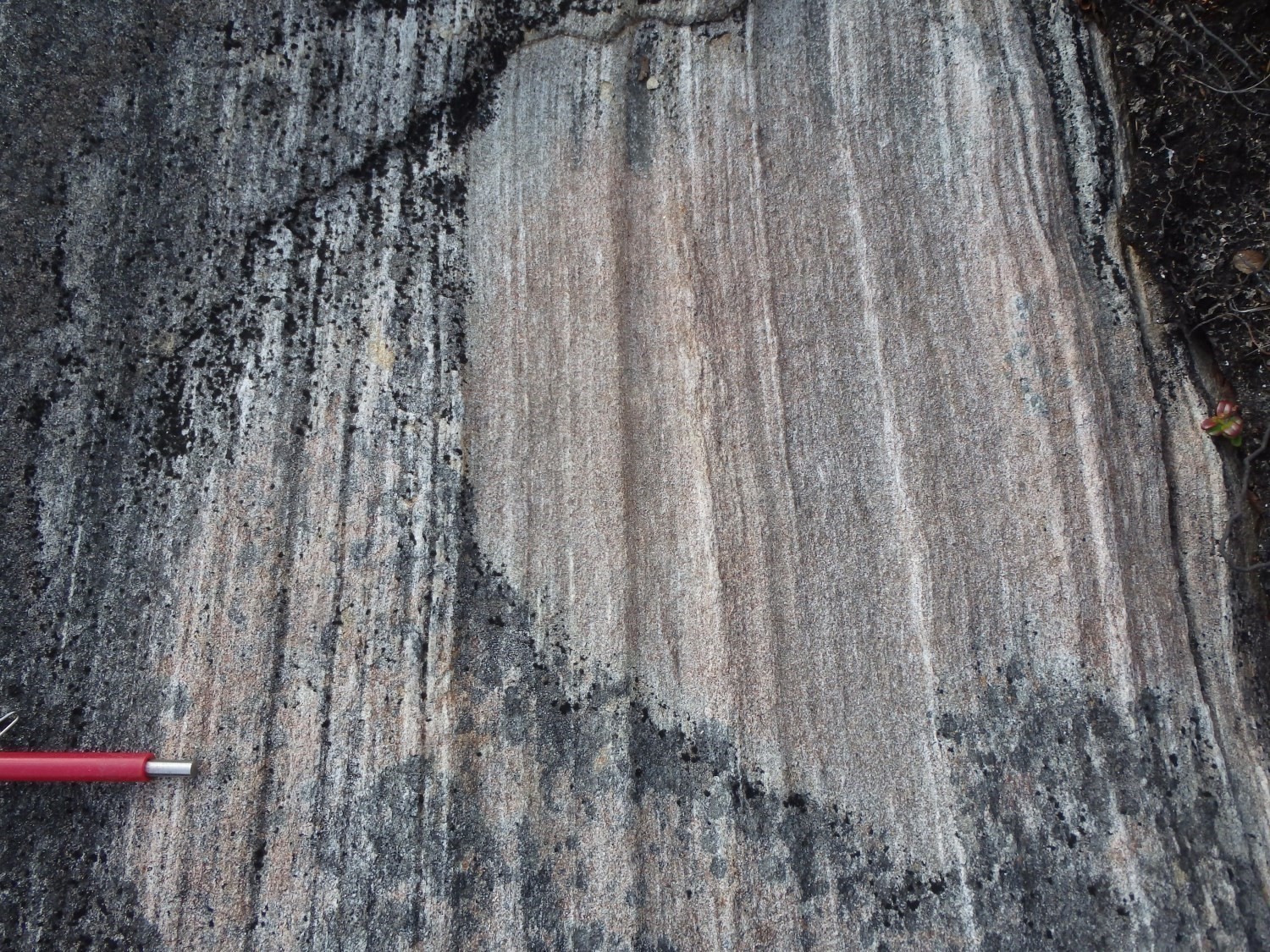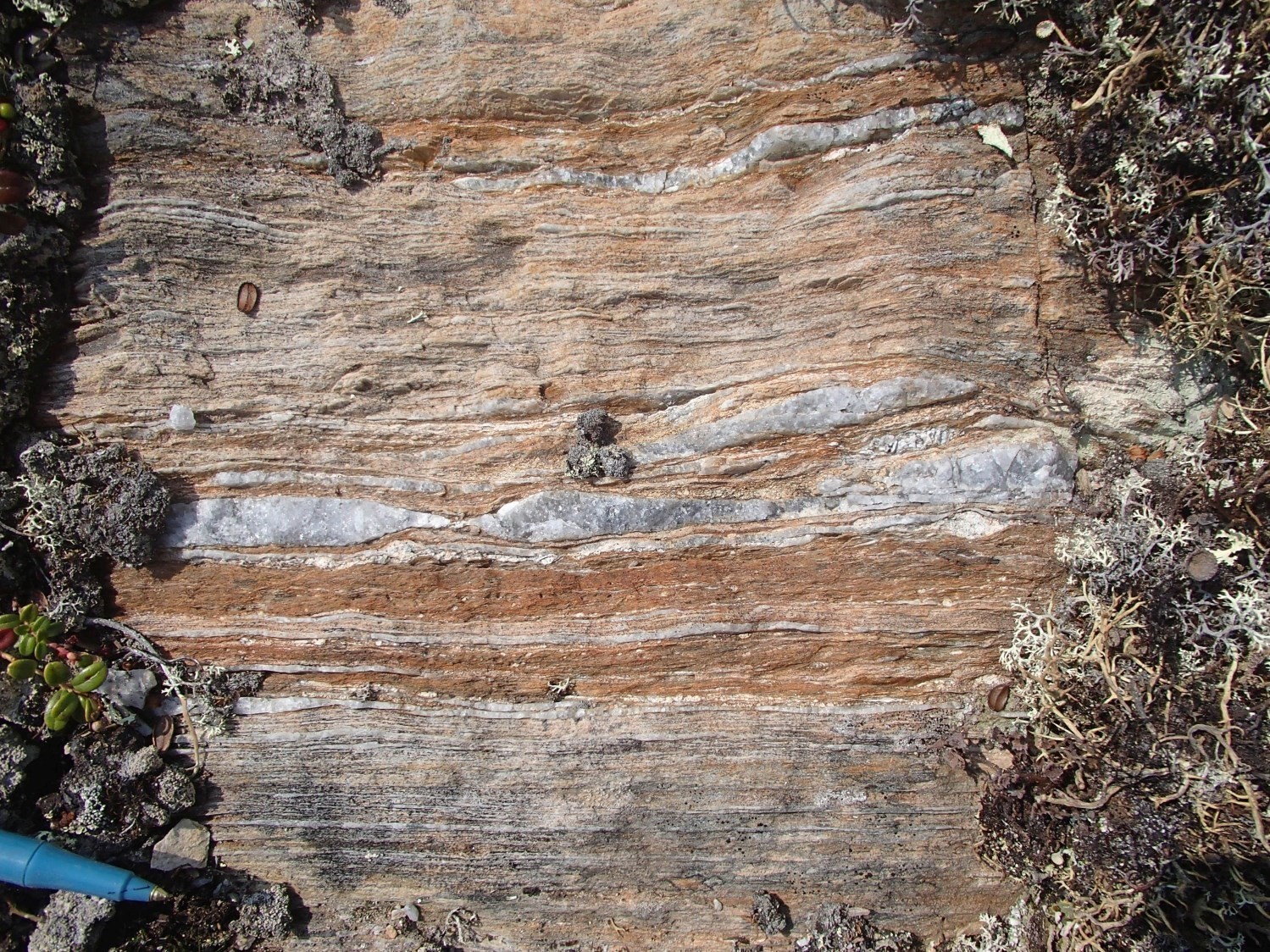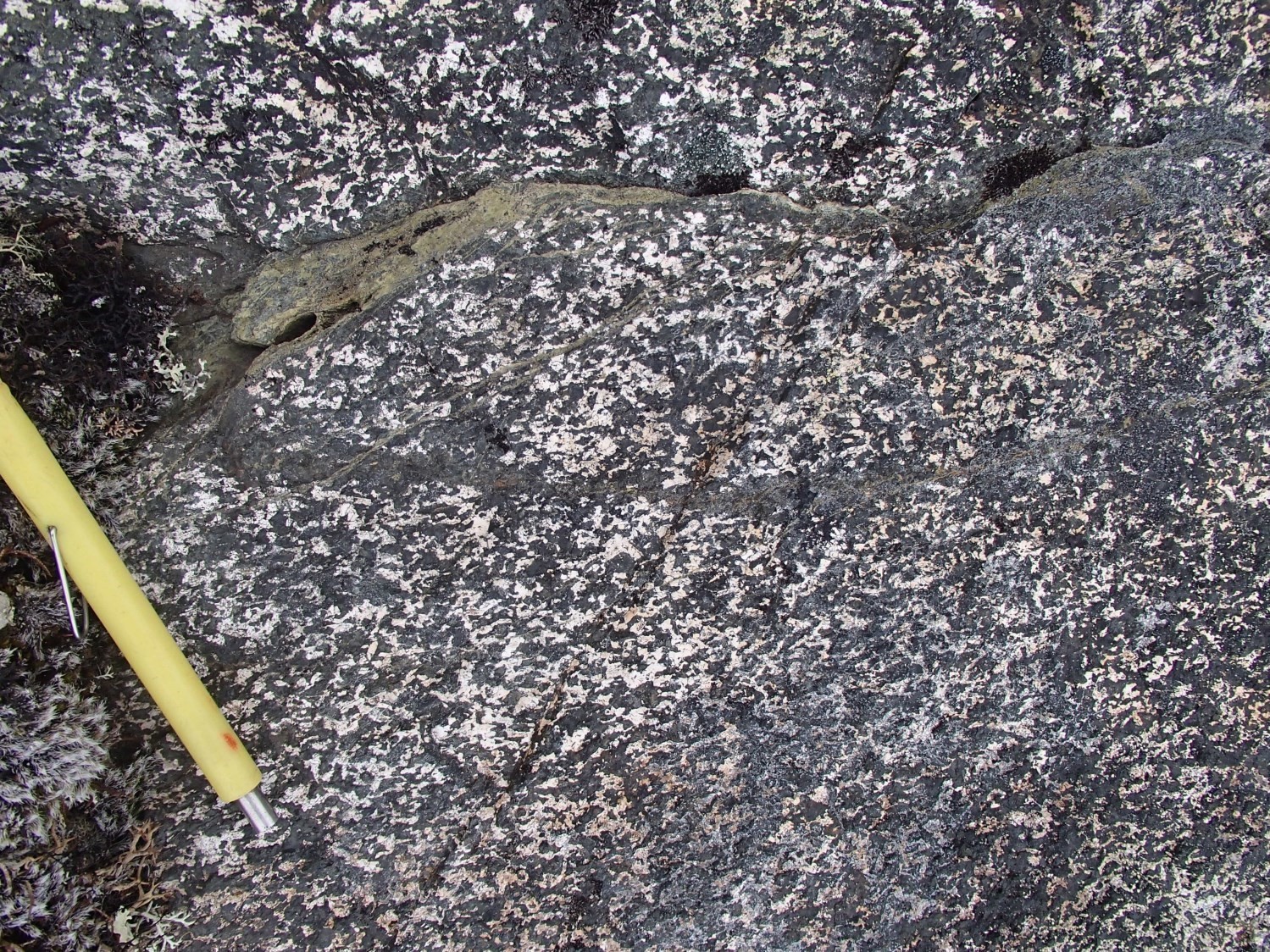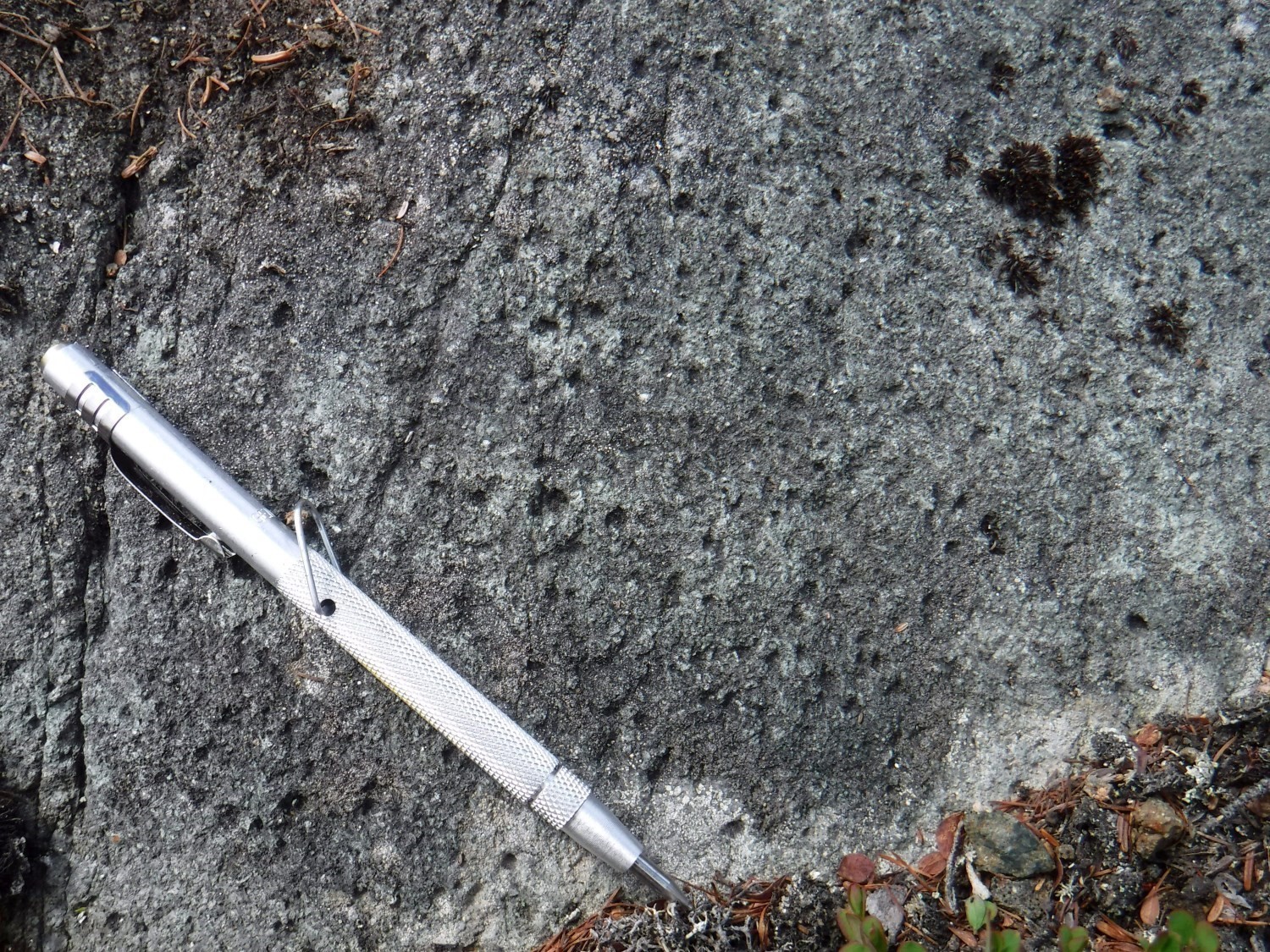
DISCLAIMER: This English version is translated from the original French. In case of any discrepancy, the French version shall prevail.
| Author(s): | Lafrance et al., 2015 |
| Age: | Neoarchean |
| Stratotype: | None |
| Type area: | Henrietta Lake and Brisson Lake areas (NTS sheets 24H and 24A) |
| Geological province: | Churchill Province |
| Geological subdivision: | George Lithotectonic Domain |
| Lithology: | Volcano-sedimentary rocks |
| Category: | Lithodemic |
| Rank: | Complex |
| Status: | Formal |
| Use: | Active |
None
Background
The « Tunulic Belt » was introduced to describe a strip of metamorphosed volcano-sedimentary rocks located in the SW portion of the Henrietta Lake area (Lafrance et al., 2015). It has also been recognized in the Brisson Lake (Lafrance et al., 2016) and Jeannin Lake (Charette et al., 2016) areas. As part of the Southeastern Churchill Province regional synthesis (SECP; Lafrance and Charette, 2018), it has been renamed the Tunulic Complex because of its assemblage of rocks of different genetic classes. In the southern portion of the SECP, some units of the Tunulic Complex had been associated by various authors with the George Complex, as well as with the Atshakash Complex (Owen, 1989; Girard, 1990; Danis, 1991; van der Leeden, 1994, 1995). The unit is named after the Tunulic River, which crosses the western border of sheets 24H05 and 24H12.
Description
The various units of the Tunulic Complex are commonly interstratified. They are cut by a granular, whitish granitic phase resembling rocks of the Guesnier Complex nApPges2 unit, by granodiorite and granite dykes (locally porphyraceous) of the De Pas Granitic Suite (pPdep), and by millimetric quartz veinlets. Also observed in the volcano-sedimentary sequence are tonalite and biotite diorite dykes, greyish, homogeneous, fine to medium-grained, and containing small feldspar phenocrystals and amphibolitized basalt enclaves. Most of these intrusions are parallel to banding or regional foliation. Metavolcanic and metavolcaniclastic units of the Tunulic Complex are associated with areas of moderate to high aeromagnetic susceptibility, while metasedimentary sequences correspond to areas of lower magnetic susceptibility.
Located in the Rivière George Shear Zone (ZCrge) influence zone, rocks are often deformed, gneissic or mylonitic in appearance, making it difficult to distinguish between tonalitic intrusions and felsic metavolcanics. In these areas, protomylonitic to ultramylonitic foliation gives a banded appearance characteristic of these deformation zones, and extensive recrystallization preserves very few primary textures. Girard (1990) also mentions the presence of tectonic breccias containing metric amphibolite fragments, oblong, angular or pinched, floating in a quartzofeldspathic matrix. The complex consists of four informal units: 1) felsic metavolcanics, metavolcaniclastics and metabasalt (nAtun1); 2) metasedimentary rocks (nAtun2); 3) amphibolitized gabbro (nAtun3); and 4) metapyroxenite and metaperidotite (nAtun4).
Tunulic Complex 1 (nAtun1): Metavolcaniclastics, Felsic Metavolcanics and Metabasalt
Unit nAtun1 consists of felsic metavolcanics, felsic to intermediate metavolcaniclastics and amphibolitized basalt. It also includes metric to hectometric meta-arkose beds, similar to those observed in unit nAtun2. In outcrop, these various lithologies alternate sharply in decimetric to hectometric layers. Mostly rhyolitic, rhyodacitic or andesitic felsic rocks form the thickest units of the complex. They are fine to very fine grained, beige to pinkish grey in alteration patina and grey, locally greenish, in fresh exposure. Chlorite, sericite, epidote and hematite alteration are common. Quartz tends to form thin, discontinuous millimetric bands.
Metavolcaniclastics consist of ash or plagioclase-quartz crystal tuffs, locally lapilli and block tuffs, showing lamination or banding characterized by alternating millimetric to centimetric leucocratic and mesocratic laminae or bands. Unit nAtun1 felsic to intermediate rocks contain 4 to 20% ferromagnesian minerals, mainly chlorite and chloritized biotite, epidote and hornblende (<3%). These minerals generally concentrate around felsic lapillis or quartz grains. The main accessory minerals are muscovite, chloritoid, opaque minerals, apatite, sphene and allanite. In places, sphene forms a reaction rim around iron oxides, a characteristic of metamorphic sphene. Some deformed metavolcaniclastic layers contain garnet and feldspar porphyroblasts.
In the Mistinibi Lake area, van der Leeden (1995) also mentions the presence of metric layers of metavolcaniclastics, augen biotite-muscovite-actinolite schists, as well as felsic lava. Eyes are up to 4 mm long and composed of feldspar and fine-grained trondhjemite fragments. Felsic lava is massive, consisting of grey-white rhyolite or dacite, and also contains millimetric quartz eyes.
Metabasalt is homogeneous, fine to very fine grained, black in altered surface and dark green in fresh exposure. It is usually granoblastic to nematoblastic, even grained, foliated and banded, locally schistose, laminated or slightly foliated. Centimetric banding is caused by a variation in the proportion of ferromagnesian minerals. Though deformed, pillow facies have been preserved locally in amphibolitized basalt, which then shows aphanitic black edges similar to hyaloclastites around flattened and disaggregated pillows. Metabasalt contains 50 to 65% ferromagnesian minerals, mainly green hornblende and lower amounts of clear actinolite needles, variously chloritized brown biotite (2-5%) and epidote (1-3%). The main accessory minerals are opaque minerals (magnetite and ilmenite), sphene, apatite, quartz and zircon. The rock locally shows a spotted texture caused by garnets (<1 mm) or hornblende porphyroblasts. Amphibolite layers are typically decimetric to metric, interstratified with felsic to intermediate and metasedimentary units of the Tunulic Complex.
Tunulic Complex 1a (nAtun1a): Fine to Very Fine-Grained Metabasalt
In the southern portion of the SECP, slightly thicker strips of metabasalt were identified by Owen (1989) and Danis (1991) in the Atshakash Complex. These have been grouped into subunit nAtun1a. Metabasalt is fine to very fine grained.
Tunulic Complex 2 (nAtun2): Banded Paragneiss
Unit nAtun2 consists of banded metasedimentary rocks, fine to very fine-grained, which have a granoblastic texture. The rock shows a brownish to rusty grey alteration patina and a light to dark grey fresh exposure. Two types of banding are observed: one is marked by variations in modal composition and the other is marked by grain size differences in the rock; another shows sharp alternating centimetric to decametric beds of varying composition consisting mainly of metapelite, metasandstone and metawacke with, locally, quartzite and meta-arkose. This banding probably represents primary bedding. Metasedimentary rocks are migmatized in places, especially pelitic beds. Up to 25% boudinaged millimetric ribbons of whitish mobilisate are then observed. Some decimetric to metric beds of paraschist and heterogranular diatexite having biotite schlierens are also present.
Unit nAtun2 rocks are foliated, especially when affected by the ZCrge. In this zone, they show mylonitic foliation, feldspar porphyroclasts, quartz bands and ferromagnesian mineral clusters rounding other minerals. Depending on the rock composition, there is 0 to 15% microcline, 1 to 10% muscovite, 5 to 25% ferromagnesian minerals, plus quartz and plagioclase. Locally chloritized brown biotite is still present and is the main ferromagnesian phase, but there are also zones containing garnet, sillimanite or hornblende. Garnet occurs as cracked poikiloblasts containing inclusions of muscovite, biotite and quartz. Sillimanite forms millimetric to centimetric bundles of fibrous minerals concentrated along foliation planes. Accessory minerals are sparse and consist of apatite, opaque minerals (magnetite and sulphides), zircon, allanite, epidote and sphene.
In the southern part of the SECP, metasedimentary rocks located in the Tunulic Complex extension were originally associated with the Atshakash Complex (Owen, 1989; Danis, 1991; van der Leeden, 1994, 1995). The Atshakash Complex included metasedimentary units but also layers of amphibolite, now assigned to subunit nAtun1a. In addition to the metasedimentary unit described above, a schist unit (now assigned to subunit nAtun2a) was described by these authors.
Tunulic Complex 2a (nAtun2a): Biotite-Muscovite Schist
Subunit nAtun2a schist is grey in fresh exposure and reddish brown in altered patina. It is fine to medium grained, and its slate cleavage parallel to stratification results in cut up beds generally less than 10 cm (Danis, 1991). Schist is mainly composed of muscovite-biotite ± garnet ± sillimanite with hectometric interstratifications of graphite-muscovite ± garnet ± tourmaline schist. It contains quartz lenses up to 2 cm long. Owen (1989) also mentions the local presence of andalusite and tourmaline in schist. Subunit nAtun2a locally contains layers and lenses of white muscovite-tourmaline ± garnet ± biotite granitoids less than 5 m wide (van der Leeden, 1995). Accessory minerals are garnet, tourmaline, zircon, epidote and opaque minerals. Tourmaline tends to form clusters. Local quartz clusters could represent fragments from sandy beds.
Van der Leeden (1994, 1995) and Owen (1989) also mention the presence of centimetric to metric beds of cherty rocks, marbles and calcosilicate rocks in the Atshakash Complex. Metachert is massive or banded, recrystallized and light grey to dark brown. Marbles and calcosilicate rocks are medium to light grey, medium to fine grained, and well banded.
Tunulic Complex 3 (nAtun3): Amphibolitized Gabbro
Unit nAtun3 groups gabbro intrusions of probable synvolcanic origin included in volcano-sedimentary sequences of the Tunulic Complex. These intrusions generally occur as metre to hectometre-wide sills, locally dykes, and are distinguished from metabasalt by its coarser grain size and its massive to slightly foliated appearance. Unit nAtun1 metabasalt occurs locally as enclaves in gabbro.
Gabbro is homogeneous, greenish black in fresh exposure and white and black or white and green spotted in altered surface. It is medium to coarse grained. It contains 2-50% plagioclase phenocrystals 0.5 to 1.5 cm, as well as 40 to 75% ferromagnesian minerals. Locally, leucocratic zones were also observed. Gabbro shows well-preserved magmatic textures and little recrystallization, with plagioclase regularly tabular or in laths. Ferromagnesian minerals form large poikilitic crystals more finely recrystallized in the core, as well as clusters defining glomeroporphyric textures. These minerals also show a zonation formed by a core of clinopyroxene surrounded by light green actinolite, followed by a rim of dark green hornblende. Clinopyroxene is locally completely replaced by amphiboles. In some areas, biotite clusters are attached to amphiboles. Altered zones are characterized by plagioclase saussuritization and chloritization of ferromagnesian minerals. With the exception of opaque minerals (magnetite or sulphides), gabbro contains a small amount of accessory minerals, with apatite, sphene and zircon being the most common.
Tunulic Complex 4 (nAtun4): Metapyroxenite and Metaperidotite
Meta-ultramafics were mainly observed in the southern part of the SECP. They consist of pyroxenite and peridotite, but the dominant facies is rich in actinolite, which appears to replace clinopyroxene, and includes small amounts of plagioclase, biotite, chlorite and opaque minerals. The rock is green, homogeneous and fine to medium grained.
Thickness and Distribution
The Tunulic Complex is approximately 260 km long along a NNW-SSE to N-S axis that coincides with the ZCrge alignment. It is located in the George Lithotectonic Domain (Charette et al., 2018) and is 3 km to 7 km wide, in the north-central part of the domain (Henrietta Lake area), and 3 km to 14 km in the Brisson Lake area (south-central part of the domain). Further south, the Tunulic Complex forms dismembered and folded kilometric klippes in tonalitic gneiss of the Saint-Sauveur Complex (ApPgss), or forms enclaves in the De Pas Supersuite (pPbdp). Van der Leeden (1994) reported that the Atshakash Complex (mostly represented by the nAtun2 unit) had an apparent thickness ranging from 0.7 to 2.4 km and a length of ~57 km.
Units nAtun1 and nAtun2 make up the majority of the outcrops observed and cover an area of 833 km2 and 355 km2 respectively. Units and subunits nAtun1a (34 km2), nAtun2a (37 km2), nAtun3 (127 km2) and nAtun4 (3 km2) are smaller in size.
Dating
Dating in a felsic metavolcaniclastic rock from an outcrop in the northern part of the Tunulic Complex yielded LA-ICPMS analyses scattered between the ages 2719 ±44 Ma and 2478 ±24 Ma. These ages were interpreted by Davis et al. (2018) to indicate that the metavolcanoclastic rock contains a strong component of post-Archean, but pre-Hudsonian detrital zircons. Results indicate that the Tunulic Complex was probably emplaced between 2719 and 2600 Ma. Other datings also gave crystallization ages between 2698 and 2643 Ma, confirming the Neoarchean age dominance of the Tunulic Complex.
| Unit | Sample Number | Isotopic System | Mineral | Crystallization Age (Ma) | Inherited Age (Ma) | Metamorphic Age (Ma) | Reference(s) |
| nAtun1 | 2013-LP-2184A | U-Pb | Zircon | 2719 ±44 à 2478 ±23 | – | – | Davis et al., 2018 |
| 2014-RP-7097A | U-Pb | Zircon | 2565,3 ±4,2 | 2639,8 ±4,7 | – |
David, 2019 |
|
| 2016-MV-4064A | U-Pb | Zircon |
2663,9 ±2,9 |
– | – | Davis and Sutcliffe, 2018 | |
| 14CXA-D090A1 | U-Pb | Zircon | 2698 ±8 | 2855; 2807 | 2543 ±20 | Corrigan et al., 2018 | |
| 14CX-D075A1 | U-Pb | Zircon | 2648 ±8 | – | 1831 ±12 | Corrigan et al., 2018 |
Stratigraphic Relationship(s)
The different units of the Tunulic Complex are cut by a whitish and granular granitic phase similar to that of the Guesnier Complex nApPges2 unit, as well as by granodiorite and granite dykes of the De Pas Granitic Suite (pPdep). The Tunulic Complex also occurs as klippes inside gneiss of the Saint-Sauveur Complex (ApPges), as well as as enclaves in intrusions of the De Pas Supersuite (pPbdp). Imprecise structural relationships between the different units of the complex do not allow to define the stratigraphic succession (van der Leeden, 1994).
Girard (1990) suggested that some of the rocks previously assigned to the George and Atshakash complexes would represent a highly deformed equivalent of rocks observed in the Nthusku Complex. The latter, however, corresponds to another volcano-sedimentary sequence, around 2373 Ma (Corrigan et al., 2018; Davis and Sutcliff, 2018), associated with the Mistinibi-Raude Lithotectonic Domain, located east of the ZCrge.
Paleontology
Does not apply.
References
Publications available through SIGÉOM Examine
CHARETTE, B., LAFRANCE, I., MATHIEU, G., 2016. Géologie de la région du lac Jeannin, Québec, Canada. MERN; BG 2015-01, 1 plan.
CHARETTE, B., LAFRANCE, I., VANIER, M.-A., 2018. Domaine lithotectonique de George, sud-est de la Province de Churchill, Nunavik, Québec, Canada : synthèse de la géologie. MERN; BG 2018-11, 2 plans.
DANIS, D., 1991. GEOLOGIE DE LA REGION DU LAC RAUDE (TERRITOIRE-DU-NOUVEAU-QUEBEC). MRN; ET 88-10, 73 pages, 5 plans.
DAVID, J., 2019. Datations U-Pb dans les provinces du Supérieur et de Churchill effectuées au GEOTOP en 2014-2015. MERN, GEOTOP; MB 2019-03, 24 pages.
DAVIS, D. W., LAFRANCE, I., GOUTIER, J., BANDYAYERA, D., TALLA TAKAM, F., GIGON, J., 2018. Datations U-Pb dans les provinces de Churchill et du Supérieur effectuées au JSGL en 2013-2014. MERN; RP 2017-01, 63 pages.
DAVIS, D. W., SUTCLIFFE, C. N., 2018. U-Pb Geochronology of Zircon and Monazite by LA-ICPMS in samples from northern Quebec. UNIVERSITY OF TORONTO; MB 2018-18, 54 pages.
GIRARD, R., 1990. GEOLOGIE DE LA REGION DE LA RIVIERE DEAT (RAPPORT FINAL). MRN; MB 90-15, 154 pages, 2 plans.
LAFRANCE, I., BANDYAYERA, D., BILODEAU, C., 2015. GEOLOGIE DE LA REGION DU LAC HENRIETTA (SNRC 24H). MERN; RG 2015-01, 62 pages, 1 plan.
LAFRANCE, I., BANDYAYERA, D., CHARETTE, B., BILODEAU, C., DAVID, J., 2016. GEOLOGIE DE LA REGION DU LAC BRISSON (SNRC 24A). MERN; RG 2015-05, 64 pages, 1 plan.
LAFRANCE, I., CHARETTE, B., VANIER, M.-A., 2018. Sud-est de la Province de Churchill, Nunavik, Québec, Canada: synthèse de la géologie. MERN; BG 2018-12
OWEN, J. V., 1989. GEOLOGIE DE LA REGION DU LAC LEIF (TERRITOIRE DU NOUVEAU-QUEBEC). MRN; ET 87-18, 56 pages, 3 plans.
VAN DER LEEDEN, J., 1994. GEOLOGIE DE LA REGION DU LAC DE LA HUTTE SAUVAGE (TERRITOIRE DU NOUVEAU-QUEBEC). MRN; MB 94-32, 109 pages, 2 plans.
VAN DER LEEDEN, J., 1995. GEOLOGIE DE LA REGION DU LAC MISTINIBI (TERRITOIRE DU NOUVEAU-QUEBEC). MRN; MB 95-45, 107 pages, 3 plans.
Other publications
CORRIGAN, D., WODICKA, N., McFARLANE, C.,LAFRANCE, I., VAN ROOYEN, D., BANDYAYERA, D., BILODEAU, C. 2018. Lithotectonic framework of the Core Zone, Southeastern Churchill Province Geoscience Canada; volume 45, pages 1-24. https://doi.org/10.12789/geocanj.2018.45.128
Suggested citation
Ministère de l’Énergie et des Ressources naturelles (MERN). Tunulic Complex. Quebec Stratigraphic Lexicon. https://gq.mines.gouv.qc.ca/lexique-stratigraphique/province-de-churchill/complexe-de-tunulic_en [accessed on Day Month Year].
Contributors
|
First publication |
Isabelle Lafrance, P. Geo., M.Sc. isabelle.lafrance@mern.gouv.qc.ca (redaction) Mehdi A. Guemache, P. Geo, Ph.D. (coordination); Pierre Lacoste, P. Geo., M.Sc. (critical review); Simon Auclair, P. Geo., M.Sc. (editing); Céline Dupuis, P. Geo., Ph.D. (English version); Nathalie Bouchard (HTML editing). |


